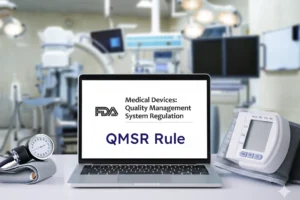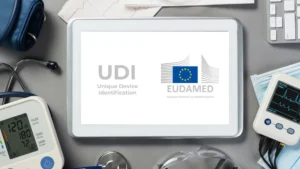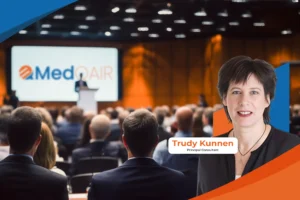MedQAIR’s Journey: Founding Story, Mission, and What Sets Us Apart (Q&A)
Regulatory compliance in the medical device industry can feel like a maze—complex, time-consuming, and often frustrating. But what if there was a way to streamline the process, making it more efficient and aligned with modern software development? That’s exactly what MedQAIR set out to achieve.
Get to know Ivo Flipse, whose expertise in biomechanics, software engineering, and quality assurance shaped MedQAIR’s mission. From growing up in a family business to tackling regulatory challenges at a multinational corporation, his journey drives our commitment to compliance and innovation.
This is just the beginning—stay tuned as we share more insights from the rest of the founding team.
1. What inspired you to start MedQAIR, and why now?
Growing up in a family that specialized in orthopedic shoes, I saw firsthand how the right medical solutions could change lives—people who arrived in pain walked out with relief. This early exposure led me to study Human Kinetics Technology, where I learned to design ergonomic devices from start to finish, focusing on requirements gathering, verification, and documentation. Later, I pursued a master’s in Human Movement Science to gain a deeper academic foundation.
My career path took me through various roles, from designing user interfaces for plantar pressure plates to working as a freelancer developing software that helped veterinarians analyze pressure measurements in animals. It was during this project that I realized my lack of programming skills limited my ability to turn ideas into reality. Determined to bridge that gap, I taught myself software development while working on the project, ultimately building the necessary skills to transition fully into software engineering.
This skillset led me to a role as a Scientific Software Engineer at Clinical Graphics, where we analyzed CT and MRI scans to assist orthopedic surgeons in diagnosing and treating patients. After Zimmer Biomet acquired the company, I found myself increasingly involved in regulatory compliance, initially filling out templates without fully understanding their purpose. As my responsibilities expanded, I transitioned from software development to product ownership and later project management. In this role, I effectively acted as a project lead, making key decisions on product development while also addressing regulatory topics to ensure compliance.
At Zimmer Biomet, we initially struggled with regulatory audits, especially since traditional compliance processes didn’t align well with agile software development. In response, our team took the initiative to rewrite our local Quality Management System from the ground up. The result? A streamlined approach that successfully supported the 510(k) clearance and MDR certification of a new medical device. Eventually, we went several years without a single nonconformity related to design control in regular audits—an achievement that validated our approach.
Throughout this journey, I developed a proactive interest in compliance, attending European SaMD meetups and engaging with peers in medtech communities. It was through these interactions that I met Leon, who would later become my co-founder. In 2024, we began collaborating as freelance consultants, and by the end of the year, I joined MedQAIR as a co-founder to bring a smarter, more efficient approach to regulatory compliance.
2. What sets MedQAIR apart from other regulatory consulting services?
MedQAIR’s approach represents the combination of Leon and myself. Leon brings a background in QA/RA leadership from SaMD companies, while I come from a software development background working on SaMD. We supplement each other very well and have a unique vision on compliance that’s different from traditional consulting firms.
When I started freelancing, I named my company “Efficient Compliance” because I believe regulatory compliance should enhance, not hinder, development. Too often, nonconformities are “fixed” by adding yet another form or procedure, instead of addressing the root cause or aligning regulations with real-world work. This results in frustrating inefficiencies that slow development to a crawl.
I’ve seen this firsthand—working with inadequate procedures where CAPAs kept piling up. My mission is to help others avoid those same pitfalls by explaining standards and regulations in a way that makes sense and by leveraging proven software development practices for compliance. Rather than introducing more bureaucracy, MedQAIR helps companies build smarter, more efficient processes that work for them.
3. What are the core values that drive MedQAIR?
Quality First: Every deliverable undergoes peer review to ensure accuracy and reliability.
Efficiency: Compliance shouldn’t slow innovation. MedQAIR ensures that regulatory processes are integrated smoothly into existing workflows.
Collaboration: MedQAIR helps teams understand and apply regulations effectively by working closely with clients, rather than just filling out forms.
4. How do you see AI transforming medical device regulations?
The regulatory landscape is evolving quickly, especially with the rise of AI in healthcare. In early 2024, the FDA significantly increased cybersecurity requirements. We worked with several clients to develop robust compliance solutions, making each implementation more streamlined than the last.
MedQAIR anticipates a similar learning curve with AI Act compliance. We’re actively working with early adopters to develop best practices, ensuring that as AI regulations solidify, our clients will be ahead of the curve rather than scrambling to catch up.
5. How do you build trust and strong relationships with your clients?
Trust is built through transparency, consistency, and collaboration. I believe in maintaining open lines of communication, ensuring clients are always informed and involved. Rather than just delivering documents, I work alongside clients to develop solutions that are practical and tailored to their needs. By making compliance a shared effort, we create a smoother, more efficient process that leads to better outcomes.
6. What’s one common misconception about medical device regulations?
Many believe that regulations themselves are the problem, but the real issue often lies in how Standard Operating Procedures (SOPs) are written. People drafting these procedures may have experience with hardware-based medical devices but lack an understanding of software development. This results in requirements that seem nonsensical to software teams—because they often are.
By bridging the gap between regulatory requirements and software development, MedQAIR ensures compliance processes make sense for both sides. Our approach focuses on reusing existing software development practices rather than introducing unnecessary forms and procedures, making compliance more intuitive and less burdensome.
7. How do you stay ahead of industry changes?
Leon Doorn actively participates in NEN commissions, contributing to the next generation of ISO standards for AI Act compliance. We also organize the European SaMD Meetup, creating a space for professionals to share insights and stay informed. Additionally, I follow many thought leaders in our space on LinkedIn to keep up with the latest developments. I also learn by doing—over the past year, I have conducted multiple cybersecurity analyses, helping companies navigate evolving regulatory expectations. These activities help us stay ahead of industry changes and provide our clients with the most up-to-date guidance.
8. What’s a lesson you’ve learned from failure?
Filling out templates without truly understanding them is a recipe for disaster. Early in my career, this led to multiple nonconformities over several years due to poorly filling in and relying on poorly designed templates. Many templates don’t fit the unique needs of SaMD, making it difficult to ensure compliance. By reading the standards themselves, we were able to understand what regulators are actually asking for, allowing us to create documentation that aligns with how we work while still satisfying regulatory requirements. This lesson now shapes MedQAIR’s approach: ensuring clients don’t just “check the boxes” but develop compliance processes that make sense for their software development practices.
9. What’s an achievement you’re particularly proud of?
After facing multiple nonconformities in the early years, my team at Zimmer Biomet went several years without a single audit finding related to design control or Software as a Medical Device. Not only did we refine our compliance approach, but we also successfully obtained 510(k) clearance for our device in a rapid timeframe. Later, we achieved MDR certification while implementing translations in the user interface. Additionally, our software was recognized for its exceptional usability, as confirmed by users during validation and usability testing.
This achievement was a testament to our commitment to quality and our ability to align compliance with agile software development—an approach that now forms the foundation of MedQAIR.
Final Thoughts
MedQAIR is a company built from firsthand experience in navigating the challenges of medical device compliance. By combining automation, efficiency, and deep industry knowledge, the experts behind MedQAIR help clients not only meet regulatory requirements but do so in a way that supports innovation rather than hindering it.
If you’re looking for a partner who understands both software development and regulatory compliance, MedQAIR might be the right fit for you.





